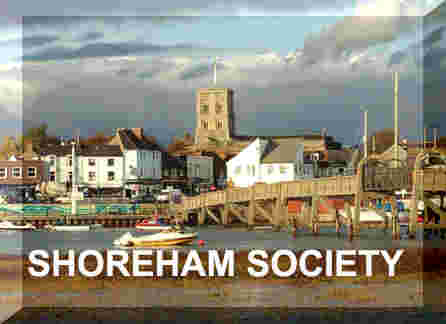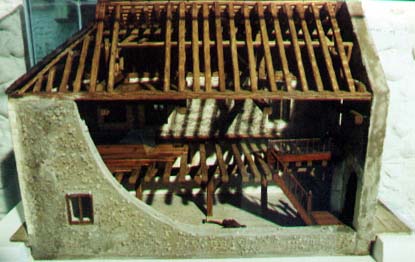Opening
Times
Thursday
to Saturday from 11am to 3pm each week, the museum is now free to visit,
with donations encouraged
10.30
am - 1.00 pm 2.00 pm - 4.30 pm Tuesday to Saturdays
Sundays
closed ? Closed all day Mondays
Entrance
fee = £3.00.
 Mrs
Vera Tickler
Mrs
Vera Tickler
Secretary
Shoreham
Society
15 Adur Avenue
Old Shoreham
BN43 5NN
Tel: 01273 885994
EMail:
Run by the Sussex
Archaeological Society
Staffed by volunteers of the
Shoreham
Society
As the Museum is staffed by
volunteers it is recommended that you ring if making a long journey.
Exhibits

Interior design , especially of the upper
floor where the Maritime paintings have sensibly been included resembles
the wooden deck of a boat (just about).
Lower floor is in blocks of stone, making
in very cool on a hot summer's day.
 Model
showing the interior
Model
showing the interior
Geological models, Flint fossils,
Memorabilia of Shoreham's history,
Maritime
Paintings (including Brook Harrison)
(top floor), with wooden flooring like the deck of a boat.
Variable Exhibitions in rear
annex.
Marlipins
(by Arthur B. Packham) ***
Link to the History
of Shoreham page
Link
to the National Maritime Museum at Greenwich
Glasgow
College of Nautical Studies
Link to Shoreham Harbour
page
Sussex
Archaeology Marlipins page

Origin of the name 'Marlipins':
to be discerned. Please enquire for more information.
Malduppine 1346
Deed. Malduppynne 1489 Deed.
Still under enquiry.
Sussex
Archaeological Society
Sussex
Archaeological Society EGroup
Sussex
Archaeology & Folklore
Escape
of King Charles II in 1651
Medieval
History: de Braose (by Lynda Denyer)
History
of the Marlipins
The initial
estimate of the date of the building is estimated to be the late 13th/early
14th century for most of the building. It status as the oldest secular
building in Britain is based not on its oldest component part but the oldest
complete building.
1346 The
deeds show the Marlipins building (now a Museum)
sold by Stephen Must. It is described as a stone corner tenement called
'Malduppine' situated in the Otmarcat .....
1489
Procession
Street is described on the south of the Malapynnys.
the building is described as a certain cellar ..... chamber or loft above
the cellar built and sold to a merchant of Suthampton.
1703
Current
spelling of Marlipins seems to have been first recorded.
1928
Marlipins was announced as a Museum, the property acquired by the Sussex
Archaeological Trust formed for this purpose.
The Marlipins
was purchased by a the Sussex Archaeological Trust in 1925, which was a
trust separate but connected with the Sussex Archaeological Society.

The building
was in a bad state of repair and the renovation was made with local contributions
towards the specially formed Sussex Archaeological Trust. It was opened
as a museum in 1928.
More historic
information can be found in the Official Guide, 16th edition.
Marlipins
Display
http://www.romansinsussex.co.uk/level3/search/museum_search.asp?museum=marlipins
Steyning
Museum
Notes:
This may mean the oldest secular building
in continual use (To differentiate it from unused barns dating back a long
time).
Its status as the oldest secular building
in England is unlikely, and is because some of the flint wall on the east
side is probably much earlier, possibly the 12th century. The oldest Deed
it may be.
The initial estimate
of the date of the building is estimated to be the late 13th/early 14th
century for most of the building. It status as the oldest secular building
in Britain is based not on its oldest component part but the the oldest
complete building still remaining in its original form.
The oldest secular buildings in England are
probably Eastry Court near Sandwich, Kent, which dates from AD 603.
Also, the Marlipins is not even the oldest building in West Sussex
as Barton Manor, Pagham, has bits of the building dating from c. 800 AD
(Guinness Book of Records 1991, p. 91). There is a timber-framed building
in Horsham, West Sussex, dendro-dated to 1295.
Lighthouses may be older.
Other buildings have not been investigated,
although there is a Moated Manor House in West Bromwich dating back to
the 13th century.
Secular means non-religious. For the purpose
of this distinction, castles and forts are also excluded.
The Hospital of St. Cross (1136) in Winchester
is a unique example of a medieval almshouse (charitable institution)
still maintained.
Some other medieval buildings:
Mermaid Inn, Rye (1420). St.
George's Guildhall, King's Lynn (1406). Merchant Adventurers' Hall,
York (1357). Chapter House (secular), Lincoln (1225). Ordsall Hall, Salford
(1350).
The Swan Inn, Fittleworth, Sussex , maintains
it has been serving ale in the same inn since 1382.
The "Fighting Cocks" PH at St. Albans, Herts
has been dated to the 11th century.
The "Royalist Hotel" at Stow-on-the Wold
is dated to the 13th century and could be much older.
Harnham
Old Mill is older but was originally ecclesiastical.
Name origin is too
problematical to be ascertained with any measure of definition.
Suggestions are usually
guess work, e.g. mardyke (historical record in ME) marl (building
material, fertiliser) marlinspike (tool) all have the wrong spelling for
the first record and are unlikely.
My creative suggestion:
First record = Malduppine
Mal = bad, from the
French and commonly adopted into the English language. (first known from
the 16th century, 1510 malfortunate).
du pine = separated
into two, so we have the last component -pine (ignoring the "pp" for the
time being) = pine, from the Latin pinus, or the OE pin.
I think this may the origin of the French surname Dupin.
Duppin
Why the "pp" if not
just an Anglicized spelling mistake? One possibility
is from Duppin in Scotland, in which a battle was fought, not long before
the name Malduppine was first in the historical record.
Mal = bad (pine), may
have been changed to mar = sea (pine). Timbers from a sea vessel rather
than cut to order.
This is not the final
say and I am not a philologist, but I venture it is better than some suggestions?
There are at least a dozen suggestions that could be said as just as bad,
e.g. pins
(small cask).
A major problem is the
current medieval roof timbers are made of Oak. These may be the originals
and they probably were, dating from at least the 14th century, and the
earliest from the late 12th century.
Name (notes):
Mèrlîn
is a type of rope (compare: marlinspike) and mèrlespi is the word
for the holes in the deck of a boat to drain water out.
